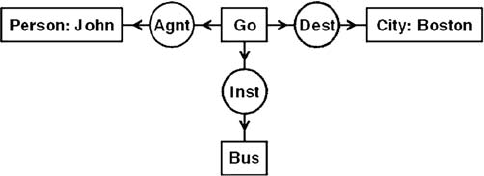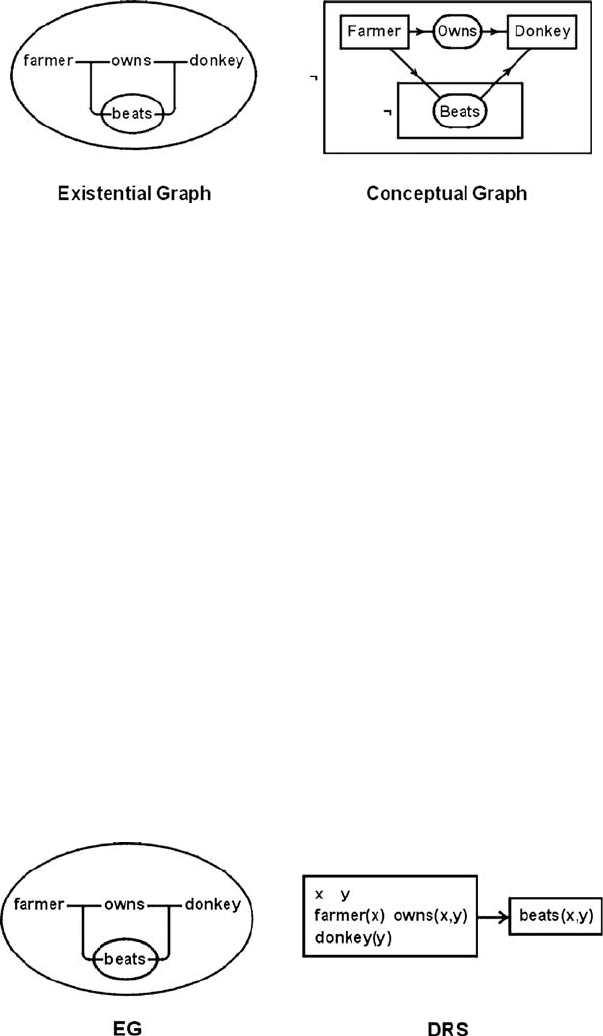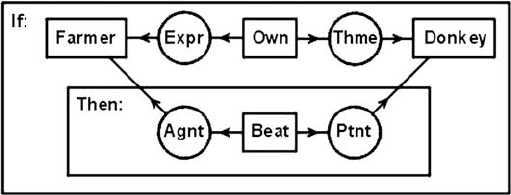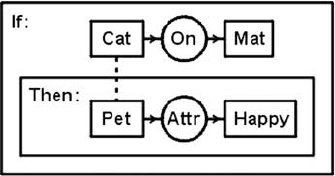Van Harmelen F., Lifschitz V., Porter B. Handbook of Knowledge Representation
Подождите немного. Документ загружается.

This page intentionally left blank
Handbook of Knowledge Representation
Edited by F. van Harmelen, V. Lifschitz and B. Porter
© 2008 Elsevier B.V. All rights reserved
DOI: 10.1016/S1574-6526(07)03005-2
213
Chapter 5
Conceptual Graphs
John F. Sowa
Abstract
A conceptual graph (CG) is a graph representation for logic based on the semantic
networks of artificial intelligence and the existential graphs of Charles Sanders Peirce.
Several versions of CGs have been designed and implemented over the past thirty
years. The simplest are the typeless core CGs, which correspond to Peirce’s original
existential graphs. More common are the extended CGs, which are a typed superset of
the core. The research CGs have explored novel techniques for reasoning, knowledge
representation, and natural language semantics. The semantics of the core and ex-
tended CGs is defined by a formal mapping to and from the ISO standard for Common
Logic, but the research CGs are defined by a variety of formal and informal extensions.
This article surveys the notation, applications, and reasoning methods used with CGs
and their mapping to and from other versions of logic.
5.1 From Existential Graphs to Conceptual Graphs
During the 1960s, graph-based semantic representations were popular in both theoret-
ical and computational linguistics. At one of the most impressive conferences of the
decade, Margaret Masterman [21] introduced a graph-based notation, called a seman-
tic network, which included a lattice of concept types; Silvio Ceccato [1] presented
correlational nets, which were based on 56 different relations, including subtype, in-
stance, part-whole, case relations, kinship relations, and various kinds of attributes;
and David Hays [15] presented dependency graphs, which formalized the notation
developed by the linguist Lucien Tesnière [40]. The early graph notations represented
the relational structures underlying natural language semantics, but none of them could
express full first-order logic. Woods [42] and McDermott [22] wrote scathing critiques
of their logical weaknesses.
In the late 1970s, many graph notations were designed to represent first-order logic
or a formally-defined subset [7].Sowa[32] developed a version of conceptual graphs
(CGs) as an intermediate language for mapping natural language questions and asser-
tions to a relational database. Fig. 5.1 shows a CG for the sentence John is going to

214 5. Conceptual Graphs
Figure 5.1: CG display form for John is going to Boston by bus.
Boston by bus. The rectangles are called concepts, and the circles are called concep-
tual relations. An arc pointing toward a circle marks the first argument of the relation,
and an arc pointing away from a circle marks the last argument. If a relation has only
one argument, the arrowhead is omitted. If a relation has more than two arguments,
the arrowheads are replaced by integers 1,...,n.
The conceptual graph in Fig. 5.1 represents a typed or sorted version of logic. Each
of the four concepts has a type label, which represents the type of entity the concept
refers to: Person, Go, Boston,orBus. Two of the concepts have names, which
identify the referent: John or Boston. Each of the three conceptual relations has a
type label that represents the type of relation: agent (Agnt), destination (Dest), or
instrument (Inst). The CG as a whole indicates that the person John is the agent of
some instance of going, the city Boston is the destination, and a bus is the instrument.
Fig. 5.1 can be translated to the following formula:
(∃x)(∃y)(Go(x) ∧ Person(John) ∧ City(Boston) ∧ Bus(y) ∧
Agnt(x, John) ∧ Dest(x, Boston) ∧ Inst(x, y)).
As this translation shows, the only logical operators used in Fig. 5.1 are con-
junction and the existential quantifier. Those two operators are the most common in
translations from natural languages, and many of the early semantic networks could
not represent any others.
For his pioneering Begriffsschrift (concept writing), Frege [8] adopted a tree no-
tation for representing full first-order logic, using only four operators: assertion (the
“turnstile” operator ), negation (a short vertical line), implication (a hook), and the
universal quantifier (a cup containing the bound variable). Fig. 5.2 shows the Begriffs-
schrift equivalent of Fig. 5.1, and following is its translation to predicate calculus:
∼(∀x)(∀y)(Go(x) ⊃ (Person(John) ⊃ (City(Boston) ⊃
(Bus(y) ⊃ (Agnt(x, John) ⊃ (Dest(x, Boston) ⊃
∼ Inst(x, y)))))))
Frege’s choice of operators simplified his rules of inference, but they lead to awk-
ward paraphrases: It is false that for every x and y,ifx is an instance of going then if
John is a person then if Boston is a city then if y is a bus then if the agent of x is John
then if the destination of x is Boston then the instrument of x is not y.
Unlike Frege, who rejected Boolean algebra, Peirce developed the algebraic nota-
tion for first-order logic as a generalization of the Boolean operators. Since Boole
treated disjunction as logical addition and conjunction as logical multiplication,

J.F. Sowa 215
Figure 5.2: Frege’ s Begriffsschrift for John is going to Boston by bus.
Peirce [24] represented the existential quantifier by Σ for repeated disjunction and
the universal quantifier by Π for repeated conjunction. In the notation of Peirce [25],
Fig. 5.1 could be represented
Σ
x
Σ
y
(Go(x) • Person(John) • City(Boston) • Bus(y) •
Agnt(x, John) • Dest(x, Boston) • Inst(x, y)).
Peano adopted Peirce’s notation, but he invented new symbols because he wanted
to mix mathematical and logical symbols in the same formulas. Meanwhile, Peirce
began to experiment with relational graphs for representing logic, as in Fig. 5.3.In
that graph, an existential quantifier is represented by a line of identity, and conjunc-
tion is the default Boolean operator. Since Peirce’s graphs did not distinguish proper
names, the monadic predicates isJohn and isBoston may be used to represent names.
Following is the algebraic notation for Fig. 5.3:
Σ
x
Σ
y
Σ
z
Σ
w
(Go(x) • Person(y) • isJohn(y) • City(z) • isBoston(z) •
Bus(w) • Agnt(x, y) • Dest(x, z) • Inst(x, w)).
Peirce experimented with various graphic methods for representing the other oper-
ators of his algebraic notation, but like the AI researchers of the 1960s, he could not
find a good way of expressing the scope of quantifiers and negation. In 1897, how-
ever, he discovered a simple, but brilliant innovation for his new version of existential
graphs (EGs): an oval enclosure for showing scope [27]. The default operator for an
oval with no other marking is negation, but any metalevel relation can be linked to the
oval. Sowa [33] adopted Peirce’s convention for CGs, but with rectangles instead of
ovals: rectangles nest better than ovals; and more importantly, each context box can
be interpreted as a concept box that contains a nested CG. A nest of two negations
Figure 5.3: Peirce’s relational graph for John is going to Boston by bus.

216 5. Conceptual Graphs
Figure 5.4: EG and CG for If a farmer owns a donkey, then he beats it.
indicates an implication, as in Fig. 5.4, which shows an EG and a CG for the sentence
If a farmer owns a donkey, then he beats it.
As Fig. 5.4 illustrates, the primary difference between EGs and CGs is the interpre-
tation of the links: in EGs, each line of identity represents an existentially quantified
variable, which is attached to the relations; in CGs, the concept boxes represent exis-
tential quantifiers, and the arcs merely link relation nodes to their arguments. Another
difference is that the CG type labels become monadic relations in EGs. Unlike EGs,
in which an unmarked oval represents negation, the symbol
∼ marks a negated CG
context. Both the EG and the CG could be represented by the following formula:
∼(∃x)(∃y)(Farmer(x) ∧ Donkey(y) ∧ Owns(x, y) ∧ ∼ Beats(x, y)).
In order to preserve the correct scope of quantifiers, the implication operator ⊃
cannot be used to represent the English if–then construction unless the existential
quantifiers are moved to the front and converted to universals:
(∀x)(∀y)((Farmer(x) ∧ Donkey(y) ∧ Owns(x, y)) ⊃ Beats(x, y)).
In English, this formula could be read For every x and y,ifx is a farmer who
owns a donkey y, then x beats y. The unusual nature of this paraphrase led Kamp
[18] to develop discourse representation structures (DRSs) whose logical structure is
isomorphic to Peirce’s existential graphs (Fig. 5.5).
Kamp’s primitives are the same as Peirce’s: the default quantifier is the existential,
and the default Boolean operator is conjunction; negation is represented by a context
box, and implication is represented by two contexts. As Fig. 5.5 illustrates, the nesting
Figure 5.5: EG and D RS for If a farmer owns a donkey, then he beats it.

J.F. Sowa 217
Figure 5.6: CG with case relations shown explicitly.
of Peirce’s contextsallowsthe quantifiers in the antecedentof an implication to include
the consequent within their scope. Although Kamp connected his boxes with an arrow,
he made exactly the same assumption about the scope of quantifiers. Kamp and Reyle
[19] went much further than Peirce in analyzing discourse and formulating the rules
for interpreting anaphoric references, but any rule stated in terms of the DRS notation
can also be applied to the EG or CG notation.
The CG in Fig. 5.4 represents the verbs owns and beats as dyadic relations. That
was the choice of relations selected by Kamp, and it can also be used with the EG
or CG notation. Peirce, however, noted that the event or state expressed by a verb is
also an entity that could be referenced by a quantified variable. That point was inde-
pendently rediscovered by linguists, computational linguists, and philosophers such as
Davidson [6].TheCGinFig. 5.6 shows a representation that treats events and states
as entities linked to their participants by case relations or thematic roles.
The type labels If and Then in Fig. 5.6 are defined as synonyms for negated
contexts. The state of owning is linked to its participants by the relations experiencer
(Expr) and theme (Thme), and the act of beating by the relations agent (Agnt) and
patient (Ptnt). Following is the equivalent in typed predicate calculus:
∼(∃x:Farmer)(∃y:Own)(∃z:Donkey)(Expr(y, x) ∧ (Thme(y, z) ∧
∼(∃w:Beat)(Agnt(w, x) ∧ Ptnt(w, z))).
The model-theoretic semantics for the EGs and CGs shown in this section is spec-
ified in the ISO standard for Common Logic (CL) [17]. Section 5.2 of this article
briefly describes the CL project, the CL model theory, and the mapping of the CL ab-
stract syntax to and from the Conceptual Graph Interchange Format (CGIF), a linear
notation that represents every semantic feature of the graphs. Section 5.3 presents the
canonical formation rules for CGs andtheir use with Peirce’s rules of inference for full
FOL. Section 5.4 presents the use of CGs for representing propositions, situations, and
metalevel reasoning. Section 5.5 discusses research issues that have inspired a variety
of formal and informal extensions to the conceptual graph theory and notation.
5.2 Common Logic
Common Logic (CL) evolved from two projects to develop parallel ANSI standards
for conceptual graphs and the Knowledge Interchange Format [9]. Eventually, those
218 5. Conceptual Graphs
two projects were merged into a single ISO project to develop a common abstract
syntax and model-theoretic foundation for a family of logic-based notations [17].
Hayes and Menzel [13] defined a very general model theory for CL, which Hayes
and McBride [12] used to define the semantics for the languages RDF(S) and OWL.
In addition to the abstract syntax and model theory, the CL standard specifies three
concrete dialects that are capable of expressing the full CL semantics: the Common
Logic Interchange Format (CLIF), the Conceptual Graph Interchange Format (CGIF),
and the XML-based notation for CL (XCL). RDF and OWL can also be considered
dialects that express subsets of the CL semantics: any statement in RDF or OWL can
be translated to CLIF, CGIF, or XCL, but only a subset can be translated back to RDF
or OWL.
The CL syntax allows quantifiers to range over functions and relations, but CL re-
tains a first-order style of model theory and proof theory. To support a higher-order
syntax, but without the computational complexity of higher-order semantics, the CL
model theory uses a single domain D that includes individuals, functions, and rela-
tions. The option of limiting the domain of quantification to a single set was suggested
by Quine [29] and used in various theorem provers that allow quantifiers to range over
relations [3].
Conceptual graphs had been a typed version of logic since the first publication in
1976, but Peirce’s untyped existential graphs are sufficiently general to express the full
CL semantics. Therefore, two versions of the Conceptual Graph Interchange Format
are defined in the ISO standard:
1. Core CGIF. A typeless version of logic that expresses the full CL seman-
tics. This dialect corresponds to Peirce’s existential graphs: its only primitives
are conjunction, negation, and the existential quantifier. It does permit quanti-
fiers to range over relations, but Peirce also experimented with that option for
EGs.
2. Extended CGIF. An upward compatible extension of the core, which adds a
universal quantifier; type labels for restricting the range of quantifiers; Boolean
contexts with type labels If, Then, Either, Or, Equivalence, and Iff;
and the option of importing external text into any CGIF text.
Although extended CGIF is a typed language, it is not strongly typed, because type
labels are used only to restrict the range of quantifiers. Instead of causing a syntax
error, as in the strongly typed logic Z [16], a type mismatch in CGIF just causes the
subexpression in which the mismatch occurs to be false. If a typed sentence in Z is
translated to CGIF, it will have the same truth value in both languages, but a type
mismatch, such as the following, is handled differently in each:
~[ [Elephant: 23] ]
This CGIF sentence, which is syntactically correct and semantically true, says that
23 is not an elephant. If translated to Z, however, the type mismatch would cause a
syntax error. The more lenient method of handling types is necessary for representing
sentences derived from other languages, both natural and artificial. RDF and OWL,
for example, can be translated to CGIF and CLIF, but not to Z.
J.F. Sowa 219
The conceptual graph in Fig. 5.1, which represents the sentence John is going to
Boston by bus, can be written in the following form in extended CGIF:
[Go *x] [Person: John] [City: Boston] [Bus *y]
(Agnt ?x John) (Dest ?x Boston) (Inst ?x ?y)
In CGIF, concepts are marked by square brackets, and conceptual relations are
marked by parentheses. A character string prefixed with an asterisk, such as *x, marks
a defining node, which may be referenced by the same string prefixed with a question
mark, ?x. These strings, which are called name sequences in Common Logic, repre-
sent coreference labels in CGIF and variables in other versions of logic. Following is
the equivalent in CLIF:
(exists ((x Go) (y Bus))
(and (Person John) (city Boston)
(Agnt x John) (Dest x Boston) (Inst x y) ))
In the CL standard, extended CGIF is defined by a translation to core CGIF, which
is defined by a translation to the CL abstract syntax. Following is the untyped core
CGIF and the corresponding CLIF for the above examples:
[*x] [*y]
(Go ?x) (Person John) (City Boston) (Bus ?y)
(Agnt ?x John) (Dest ?x Boston) (Inst ?x ?y)
(exists (x y)
(and (Go x) (Person John) (city Boston) (Bus y)
(Agnt x John) (Dest x Boston) (Inst x y) ))
In core CGIF, the most common use for concept nodes is to represent existen-
tial quantifiers. A node such as [*x] corresponds to an EG line of identity, such as
the one attached to the relation Go in Fig. 5.3. It is permissible to write names in a
concept node such as [: John], but in most cases, such nodes are unnecessary be-
cause names can also be written in relation nodes. A concept node may contain more
than one name or coreference label, such as [: John ?z]. In EGs, that node cor-
responds to a ligature that links two lines of identity; in CLIF, it corresponds to an
equality: (= John z).
Although CGIF and CLIF look similar, there are several fundamental differences:
1. Since CGIF is a serialized representation of a graph, labels such as x or y rep-
resent connections between nodes in CGIF, but variables in CLIF or predicate
calculus.
2. Since the nodes of a graph have no inherent ordering, a CGIF sentence is an
unordered list of nodes. Unless grouped by context brackets, the list may be
permuted without affecting the semantics.
3. The CLIF operator and does not occur in CGIF because the conjunction of
nodes within any context is implicit. Omitting the conjunction operator in CGIF
tends to reduce the number of parentheses.

220 5. Conceptual Graphs
Figure 5.7: CG display form for If a cat is on a mat, then it is a happy pet.
4. Since CGIF labels show connections of nodes, they may be omitted when they
are not needed. One way to reduce the number of labels is to move concept
nodes inside the parentheses of relation nodes:
[Go *x]
(Agnt ?x [Person: John])
(Dest ?x [City: Boston])
(Inst ?x [Bus])
When written in this way, CGIF looks like a frame notation. It is, however,
much more general than frames, since it can represent the full semantics of CL.
As another example, Fig. 5.7 shows a CG for the sentence If a cat is on a mat, then it is
a happy pet. The dotted line that connects the concept [Cat] to the concept [Pet],
which is called a coreference link, indicates that they both refer to the same entity. The
Attr relation indicates that the cat, also called a pet, has an attribute, which is an
instance of happiness.
The coreference link in Fig. 5.7 is shown in CGIF by the defining label *x in the
concept [Cat: *x] and the bound label ?x in the concept [Pet: ?x]. Following
is the extended CGIF and its translation to core CGIF:
[If: [Cat *x] [Mat *y] (On ?x ?y)
[Then: [Pet ?x] [Happy *z] (Attr ?x ?z) ]]
~[ [*x] [*y] (Cat ?x) (Mat ?y) (On ?x ?y)
~[ (Pet ?x) [*z] (Happy ?z) (Attr ?x ?z) ]]
In CGs, functions are represented by conceptual relations called actors. Fig. 5.8 is
the CG display form for the following equation written in ordinary algebraic notation:
y = (x + 7)/sqrt(7)
The three functions in this equation would be represented by three actors, which
are shown in Fig. 5.8 as diamond-shaped nodes with the type labels Add, Sqrt, and
Divide. The concept nodes contain the input and output values of the actors. The
two empty concept nodes contain the output values of Add and Sqrt.
In CGIF, actors are represented as relations with two kinds of arcs: a sequence of
input arcs and a sequence of output arcs, which are separated by a vertical bar:
[Number: *x] [Number: *y] [Number: 7]
(Add ?x 7 | [*u]) (Sqrt 7 | [*v]) (Divide ?u ?v | ?y)

J.F. Sowa 221
Figure 5.8: CL functions represented by actor nodes.
In the display form, the input arcs of Add and Divide are numbered 1 and 2 to
indicate the orderin which the arcs are written in CGIF.Followingis the corresponding
CLIF:
(exists ((x Number) (y Number))
(and (Number 7) (= y (Divide (Add x 7) (Sqrt 7)))))
No CLIF variables are needed to represent the coreference labels *u and *v since
the functional notation used in CLIF shows the connections directly.
CLIF only permits functions to have a single output, but extended CGIF allows
actors to have multiple outputs. The following actor of type IntegerDivide has
two inputs: an integer x and an integer 7. It also has two outputs: a quotient u and a
remainder v.
(IntegerDivide [Integer: *x] [Integer: 7] | [*u] [*v])
When this actor is translated to core CGIF or CLIF, the vertical bar is removed, and
the actor becomes an ordinary relation with four arguments; the distinction between
inputs and outputs is lost. In order to assert the constraint that the last two arguments
are functionally dependent on the first two arguments, the following CGIF sentence
asserts that there exist two functions, identified by the coreference labels Quotient
and Remainder, which for every combination of input and output values are logi-
cally equivalent to an actor of type IntegerDivide with the same input and output
values:
[Function: *Quotient] [Function: *Remainder]
[[@every*x1] [@every*x2] [@every*x3] [@every*x4]
[Equiv: [Iff: (IntegerDivide ?x1 ?x2 | ?x3 ?x4)]
[Iff: (#?Quotient ?x1 ?x2 | ?x3)
(#?Remainder ?x1 ?x2 | ?x4)]]]
Each line of this example illustrates one or more features of CGIF. The first line
represents existential quantifiers for two entities of type Function. On the sec-
ond line, the context bracket [ encloses the concept nodes with universal quantifiers,
marked by @every, to show that the existential quantifiers for Quotient and Re-
mainder include the universals within their scope. The equivalence on the last three
lines shows that an actor of type IntegerDivide is logically equivalent to a con-
junction of the quotient and remainder functions. Finally, the symbol # on the last two
